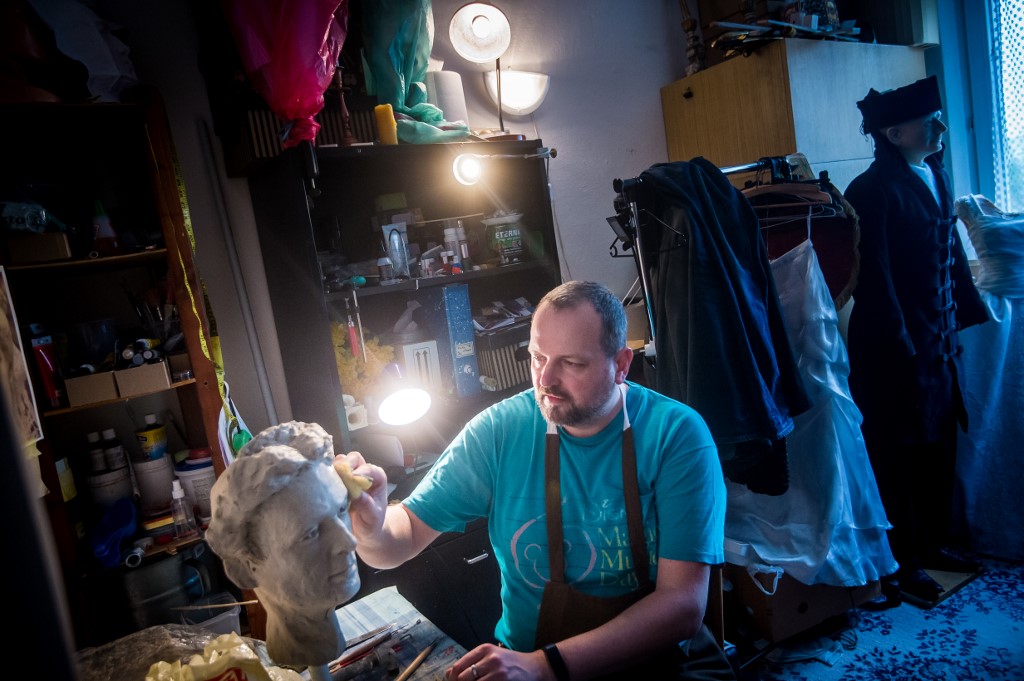The bald head of Slovak general Milan Rastislav Stefanik is pierced before hairs are inserted into his skull. Stefanik’s face remains motionless, his blue eyes do not even blink.
The late founder of the former Czechoslovakia is the latest figure to get the wax treatment from Roman Bajzik, a 48-year-old opera teacher who moonlights as Slovakia’s very own Monsieur Tussaud.

“I began creating wax sculptures back in 2002 as I wanted to see what my great-grandfather looked like,” Bajzik said, at his two-room gallery in what was once the family mill.
“I only had an old photo of him and was curious if I could turn him into something three-dimensional,” he told AFP in Zavada, a central village of 600 residents, about 150 kilometres (around 90 miles) from the capital, Bratislava.
Two decades later, there are now 23 motionless family members, royalty, folklore characters and important figures for tourists and schoolchildren to view.
Figures on display past the creaky wooden front door at the mill-turned-gallery include the vampire Nosferatu, pope John Paul II and a mermaid from Slovak mythology.
The wax museum is open by appointment only for an entry fee of two euros ($2.2).
‘Mute’
An experienced tenor who once sang at Austria’s prestigious Salzburg Festival, Bajzik studied opera directing and now teaches operatic acting at the state conservatory in Bratislava.
He likes silence when he sculpts though, usually at night to relax.
“I have enough singing during the day. I’m pleased to be surrounded by my mute figures,” he said.
He lives alone in a high-rise flat in the capital where he has turned one room into a tiny studio whose shelves are filled with chicken mesh, cornstarch, construction foam, silica gel — all used for wax modelling.
Currently he is working on two figures: Stefanik is getting his hair done, while Empress Elisabeth of Austria, better known as Sissi, is undergoing some facial work.
Bajzik consulted available photos and busts of Sissi to get her facial measurements just right.
Once the clay head is done, he casts it in plaster and then pours hot wax in the mold before fine-tuning the details.
‘Lend a hand’
Wax is ideal for models because it looks similar to human skin, said Bajzik, whose mix notably includes beeswax and paraffin.
“It has to be carefully blended as wax tends to crack when inserting hairs into the skull,” he said.
The hair comes from discount store wigs. Using a long needle, he attaches each hair into the wax skull. It is time-consuming, meticulous work.
“It took me a while to investigate how to make a hole that isn’t too large but could secure the hair. I watch instructional videos,” he said with a laugh.
Bajzik often transforms everyday items into the props he needs. When one of his kings required an imperial orb, Bajzik bought a Christmas bauble and added a small cross.
He opens a drawer full of semi-finished hands, waiting for their turn to become the appenda
ges of a king or queen.
“Hands are finicky. I usually ask someone to ‘lend a hand’ and I mold it for a figure,” Bajzik said.
“John Paul II, for example, has my hands.”
juh-amj/kjm
© Agence France-Presse